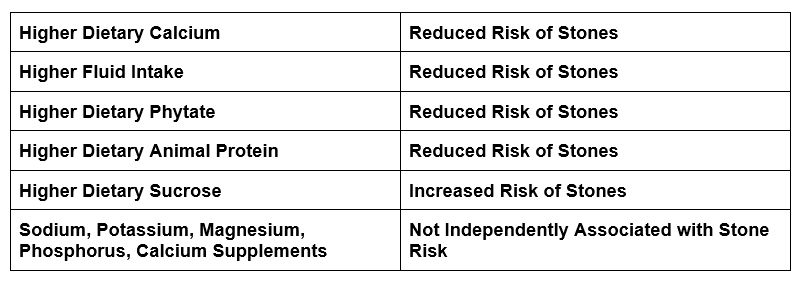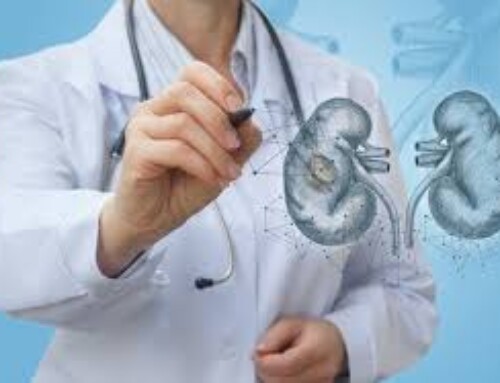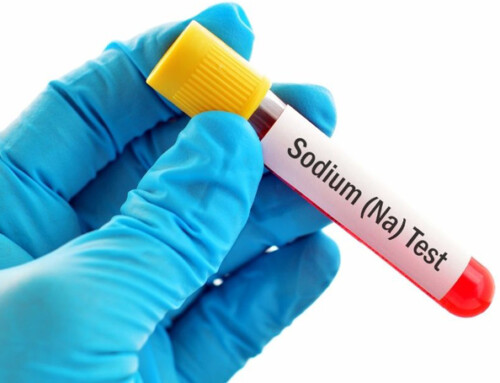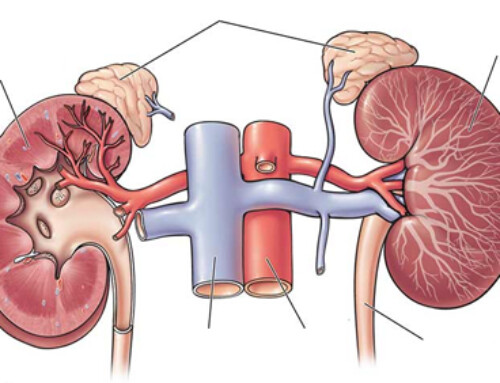Most people don’t like having kidney stone attacks and are motivated to prevent recurrences. However, there are some misconceptions. Some of the interventions patients try such as a low oxalate diet, avoiding tea, drinking citrus containing beverages or restricting dietary calcium are of minimal benefit or counter productive.
What does the data show? 8 dietary factors associated with recurrent kidney stones.
Table of Contents
Fluid Intake
How it works
This one is intuitive. The more dilute the urine the less likely it is for crystals to precipitate.
Recommendations
- How much? The recommendation is to achieve a urinary volume of least 2 liters a day (2 liters is 64 ounces). Since everything one drinks isn’t excreted in the urine (your body uses it for other things), I counsel patients to target 2.5 liters (80 ounces) Water bottles are often 16 or 20 ounces so 4-5 of these.
- What to drink? I advise water. Some people believe that citrus drinks such as orange juice helps, but the amount of citrate is nominal, and you certainly don’t want to ingest a lot of sugar/calories this will be detrimental. Adding lemon juice may be helpful. If drinking water is unpalatable add a non sugar flavoring.
Healthy Calcium Intake
This is counterintuitive as most stones are composed of calcium. Yet, studies show an increased risk of kidney stones with decreased dietary calcium.
How it works
Calcium tends to bind oxalate. (The most common stone composition is calcium oxalate). Therefore dietary calcium binds dietary oxalate. A low dietary calcium will allow more oxalate to be absorbed. The body gets calcium from the bones and there is an increased risk of stones.
Recommendations
- It is recommended to have a healthy amount of dietary calcium (800-1200 mg per day).
- What about supplements? I typically counsel patients to avoid calcium supplements as there tends to be a higher amount of calcium absorbed.
For patients with osteopenia or osteoporosis, in addition to dietary calcium I recommend vitamin D. This is not associated with stone risk unless levels are high. I do avoid active vitamin D such as calcitriol. If calcium supplements must be taken I advise they be taken with the largest meal so they may help limit oxalate absorption. It would be reasonable to assess 24 hour urine calcium before and after initiation of the calcium supplement.
Sodium Restriction
An increased dietary sodium is associated with an increased risk of stones.
How it works
When sodium passes through the kidney it “drags” calcium with it, inhibiting calcium reabsorption in the proximal tubule. The way to decrease renal sodium excretion is to decrease sodium intake. Decreasing dietary sodium from 200 mmol (approximately 4.6 grams) to 80 mmol (approximately 1.84 grams) a day can decrease the 24 hour urine calcium excretion by 100 mg.
Recommendations
- Decrease dietary sodium to less than 100 mmol (2.3 grams) per day. I typically advise less than 2 ½ grams sodium restriction.
Higher Potassium Intake
How it works
Potassium increases urinary citrate, a stone inhibitor.
Recommendations
- Healthy diet including fruits and vegetables,
Limit Animal Protein
A higher amount of non dairy animal protein, essentially meat, can increase urinary calcium contributing to stone risk. Most patients will automatically assume red meat, but any form of meat will have this effect.
How it works
Animal protein contains sulfates. When the body metabolizes this it increases the acid load. To buffer the acid calcium, from bone, is utilized. This calcium is then excreted in the urine.
However, the nurses health study: Dietary Factors and the Risk of Incident Kidney Stones in Younger Women: Nurses’ Health Study II showed dietary animal protein to bwe associated with a decreased risk of stones.
Recommendation
- I believe protein intake is important. I counsel patients to use a 4 – 6 ounce portion as opposed to 8-12 ounce. Supplement protein with dairy or plant based sources.
Phytate
Phytate is a substance in plants. In the diet it is found in legumes, nuts and seeds
How it Works
Phytate limits enteric calcium absorption. It also may decrease the affinity for calcium to bind oxalate.
Recommendations
- Include as part of a healthy diet. Caution with excess, as phytate can impair the absorption of other minerals such as iron.
Caffeine
Although coffee and tea contain oxalate, they are associated with a decreased risk of stones.
Coffee and Caffeine Consumption and Risk of Kidney Stones: A Mendelian Randomization Study – PubMed
How it works
The fluid intake helps, but in addition caffeine has a diuretic effect, increasing urinary flow rate and decreasing crystallation. Caffeine also may impair the adhesion of calcium oxalate crystals to tubular cells.
Recommendation
- Moderate amounts of coffee and tea need not be avoided. However avoid sugared iced tea – see below
Sugar
Sucrose and fructose are associated with an increased risk of stones
How it Works
Sucrose and fructose affect the urinary chemistry in a number of ways that are associated with increased stone risk including:
- Calcium
- Oxalate
- Uric acid
- pH
What’s Not on this List
Oxalate. Many patients initially follow a low oxalate diet, however this approach is of limited benefit.
Although ingestion of high oxalate foods can contribute to hyperoxaluria, a significant amount of oxalate is produced endogenously.
I counsel patients to avoid very high oxalate foods such as:
- Spinach
- Rhubarb
- Almonds
If one avoids high oxalate foods, trying to further decrease urinary oxalate by dietary restriction has diminishing returns. Efforts would be better used to increase fluid intake and decrease sodium or sugar intake.
I also recommend avoiding high doses of vitamin C as this can increase endogenous oxalate production.
Studies
Dietary Factors and the Risk of Incident Kidney Stones in Younger Women: Nurses’ Health Study II

Dietary Risk Factors for Incident and Recurrent Symptomatic Kidney Stones – ScienceDirect

Summary
This can be summarized simply as “eat healthy”. By following this diet one is:
- Drinking a lot of water
- Limiting salt and sugar
- Eating fruits and vegetables (potassium and phytate)
- Moderating meat portions
- Treating themselves to a cup or two of coffee




